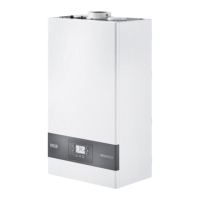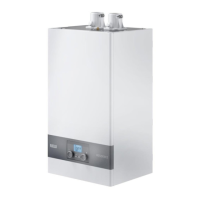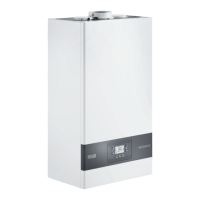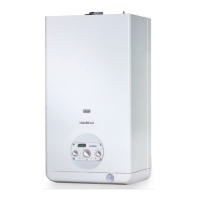21
INSTALLATION
2.6.2 Flow limits
RTC boilers does not require a minimum ow rate in order to maintain warranty. The boiler has been designed to operate with a tem-
perature difference between the supply and return of up to 100 °F. Flow should be initiated with the start of the burner to minimize
temperature uctuations and control deviations. The eld installed manual reset high limit (as required by CSD-1) must be tted to the
instrument tapping of the heating supply, set to 210°F and electrically connected into the Control unit or the burner enable/disable
circuit directly.
RTC boilers can operate with zero ow, but this condition is not recommended for long time to avoid over-temperatures.
It is recommended a minimum ow only to have heat transfer and a maximum ow, to prevent erosion.
Model
Flow Limits
Maximum Minimum
RTC 3000 360 40 GPM
RTC 4000 550 50 GPM
RTC 5000 650 60 GPM
RTC 6000 750 75 GPM
RTC 8000 1,150 100 GPM
RTC 10000 1,250 120 GPM
2.6.3 Water quality requirements
The manufacturer recommends the use of water as heat transfer
uid for the central heating system. A chemical treatment system
must be provided for this water.
The heat transfer uid (water) for the central heating circuit must
conform to the quality parameters given in the following table:
Chemical and physical requirements of heating system water
Initial lling
water
Regular service
water (*)
ph 6-8 7.5-9.5
Hardness °fH / ppm < 5° / 50 < 5° / 50
Electrical con-
ductivity
μs/cm < 100
Chlorides mg/l / ppm < 10 / 10
Sulphides mg/l / ppm < 10 / 10
Nitrides mg/l / ppm < 10 / 10
Iron mg/l / ppm < 0.5 / 0.5
(*) values for water in system after 8 weeks of functioning
9
NOTICE:
If it proves impossible to treat the heating system water
supply properly because the water charging system is
automatic and uncontrolled, if there are no barriers
installed to prevent water oxygenation and if the heating
system includes an open expansion vessel, then the
boiler itself must be separated from the heating system by
means of a heat exchanger.
If the hardness of the water exceeds the value specied in the
table, it is mandatory to install a water softening system.
9
NOTICE:
− Chemical products used for water treatment must be com-
patible with applicable water pollution laws.
− Provided they are properly applied, these laws guarantee
the safe functioning of the heating system.
2.6.4 Central heating system
Possible causes for corrosion and limescale
Typical problems encountered in central heating systems include:
− the breakage of heated surfaces through overheating
caused by the thermal insulation of limescale deposits on
the water side
− oxygen corrosion
− deposit corrosion
− stray current corrosion
− diffused and localized acid corrosion.
The technical details provided in this section refer specically to
domestic and industrial hot water heating systems with working
temperatures up to 210°F (99°C).
2.6.5 New central heating systems
Mistakes to avoid and precautions.
To eliminate contact between system water and the air, the fol-
lowing is required:
− ensure that the expansion vessel is a closed vessel, and
of the correct size and pre-charge pressure (the pressure
should be checked periodically)
− ensure that the system is always kept at a pressure high-
er than atmospheric pressure at all points (including the
pump suction side) and at all operating conditions (pre-
cisely because the seals, gaskets and joints in a water cir-
cuit are designed to resist pressure from within, but not to
resist a vacuum within)
− ensure that no part of the system is made from materials
that are permeable to gases (e.g. plastic pipes with no ox-
ygen barrier used in oor heating systems).
9
NOTICE:
The original system lling water and any topping up water
must always be ltered (using synthetic or metal mesh
lters with a ltration rating of no less than 50 microns)
to prevent sludge from forming and triggering deposit
induced corrosion.
